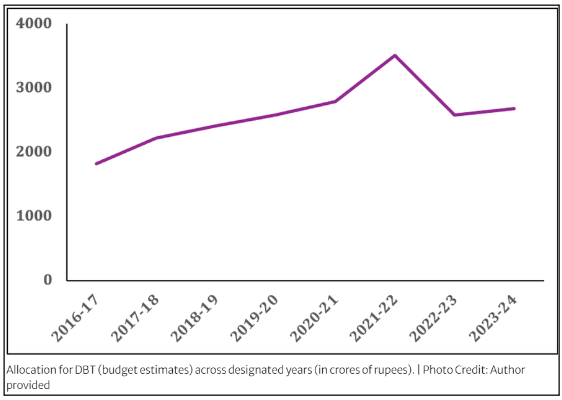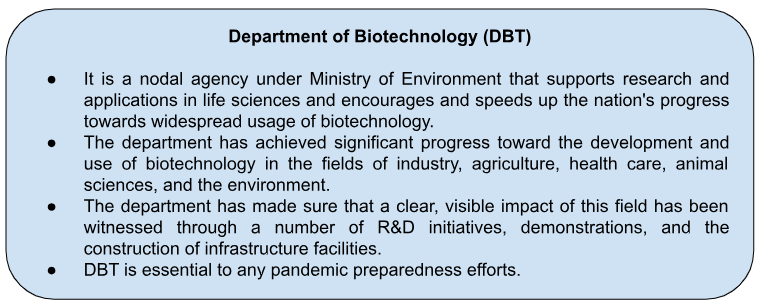GS Paper III
News Excerpt:
Recently, the Department of Biotechnology (DBT) has issued the ‘Guidelines for Genetically Engineered (GE) Insects’.
Prospects of India’s Bioeconomy:
- India's bioeconomy accounts for 2.6% of the country's GDP.
- According to the DBT "Bioeconomy Report 2022", this contribution should be closer to 5% by 2030.
- The current allocation for DBT is only 0.0001% of India’s GDP.
- However, neither the DBT's funding nor its recent policies - which serve as India's main biotechnology promoter - indicate a sincere desire to advance this industry.

Challenges in creating GE insects:
- Uncertainty of purpose:
-
- The guidelines acknowledge that genetically engineered insects are becoming widely available across the globe.
- However, it does not outline the uses of GE insects or how the DBT should envision their use.
- The guidelines only offer regulatory processes for research and development on insects that have some useful uses.
- Current biotechnology-based policies are not in sync with the broader commitment to contributing to the bioeconomy.
- The guidelines have been harmonised to guidance from the World Health Organisation on GE mosquitoes. Yet they seem to downplay the economic opportunities that such insects provide.
- Engineering honey bees to make better-quality/ quantities of honey will help reduce imports and also maybe facilitate exports.
- Similarly, GE silkworms may be used to produce finer and/or cheaper silk, affecting prices and boosting sales.
- But the guidelines and policy are both quiet on how GE insects can benefit the bioeconomy.
- The guidelines acknowledge that genetically engineered insects are becoming widely available across the globe.
- Uncertainty for researchers:
-
- The guidelines do not apply to constrained trials or deployment, they are solely applicable to research.
- This means, researchers can test the insects once they have been "made" and evaluated in the lab, after getting approval from MoEFCC's Genetic Engineering Appraisal Committee (GEAC).
- GE insects can’t be pulled back after deployment unlike genetically modified foods. They are not amenable to individual consumer choice.
- For example, if a consumer doesn’t want to eat a GM organism, she can choose to buy organic food or food labelled “contains no GMO”.
- But if a company decides to release a GE insect in an individual’s neighbourhood, she will have no choice but to be exposed to it.
- There’s no clarity on whether the MoEFCC will actually approve the deployment of GE insects or what criteria it might use to consider a proposal to do so.
- The guidelines do not apply to constrained trials or deployment, they are solely applicable to research.
- Uncertainty of ambit:
-
- The guidelines include standard operating procedures for genetically engineered mosquitoes, agricultural pests, and beneficial insects; however, the term "beneficial" in the context of GE insects is unclear.
- The lack of clarity will impede funders and scientists from investing in this research.
- Country like India where low public as well as private funding persist, the absence of a precise stance to identify and promote research priorities hampers progress.
- A gene-therapy product is defined as "any entity which includes a nucleic acid component being delivered by various means for therapeutic benefit" in the National Guidelines for Gene Therapy Product Development and Clinical Trials.
- However, without a "definition of therapeutic benefit," it is unclear which gene therapy items will be allowed in the end.
- Destructive products can also be accidentally created through genetic engineering.
- The guidelines include standard operating procedures for genetically engineered mosquitoes, agricultural pests, and beneficial insects; however, the term "beneficial" in the context of GE insects is unclear.
Advantages of GE insects: The development and release of GE insects offers applications in various fields such as -
- Vector management in human and livestock health.
- Management of major crop insect and pests.
- Maintenance and improvement of human health and the environment through a reduction in the use of chemicals.
- Production of proteins for healthcare purposes.
- Genetic improvement of beneficial insects like predators, pollinators (e.g. honey bee) or productive insects (e.g. silkworm, lac insect).
- Uplifting the standard of living by reducing disease burden, enabling food security and conserving the environment.
Way Forward:
- The budget allocation for DBT as well as private funding needs to be significantly increased to create an ecosystem of innovation and industrial action.
- Policies must enable risk-taking appetite within the scientists and should also be in line with the financial and social objectives of the country.
- It will be necessary to monitor the effects of GE and engage the community more broadly.
Additional information:

Prelims PYQ
Q. With reference to the Genetically Modified mustard (GM mustard) developed in India, consider the following statements: (UPSC 2018)
1) GM mustard has the genes of a soil bacterium that give the plant the property of pest-resistance to a wide variety of pests.
2) GM mustard has the genes that allow the plant cross-pollination and hybridization.
3) GM mustard has been developed jointly by the IARI and Punjab Agricultural University.
Which of the statements given above is/are correct?
(a) 1 and 3 only
(b) 2 only
(c) 2 and 3 only
(d) 1, 2 and 3
Q. A genetically engineered form of brinjal, known as the Bt-brinjal, has been developed. The objective of this is (UPSC 2011)
(a) To make it pest-resistant
(b) To improve its taste and nutritive qualities
(c) To make it drought-resistant
(d) To make its shelf-life longer
Q. Mycorrhizal biotechnology has been used in rehabilitating degraded sites because mycorrhiza enables the plants to (UPSC 2013)
- resist drought and increase absorptive area
- tolerate extremes of pH
- resist disease infestation
Select the correct answer using the codes given below.
(a) 1 only
(b) 2 and 3 only
(c) 1 and 3 only
(d) 1, 2 and 3
Mains PYQ
Q. How can biotechnology help to improve the living standards of farmers? (UPSC 2019)
Q. Why is there so much activity in the field of biotechnology in our country? How has this activity benefitted the field of biopharma?
(UPSC 2018)


